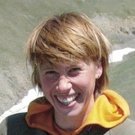When Firm Land Collapses
“The earthquakes of 2003 that shook a land which appeared rather quiescent were like a bolt from the blue… The SB RAS Geophysical Surveys recorded seventy seven Мs >3.5 shocks, M = 7.3 the largest, between September 27 and October 15 in Gorny Altai. The main shock was felt to intensity IV within 1000 km. Altogether, the activity zone has experienced over two thousand shocks, and the process still continues ever decaying…” (Novikov et al., 2005).
We were on our way back from a field trip to Mongolia when good luck (for geologists) brought us to the area of the first intensity VII-VIII shocks of the Chuya earthquake. Bunny hopping on pits and bumps, we actually missed the very first shock and realized the might of what had happened ten minutes later at the sight of the road bestrewn with rock spalls.
The Chuya earthquake of September 27, 2003 that shook the Russian Altai was the largest over the time of instrumental seismicity, but auspiciously nobody was killed.
Scientists got an opportunity to investigate the full scope of surface rupture from a large seismic event in a region of complex geomorphology.
Geological effects produced by the Chuya earthquake offer a model which can serve to identify properly numerous traces of past earthquakes in the region and thus to update existing maps of seismic risk.
Beating our way through stones, we reached Aktash village enshrouded in the darkness of a fall night. The darkness was only broken now and then by lights from self-contained current generators and fires people made in the yards. People were scared by continuing shocks preceded by underground boom and did not dare to enter their houses for several days after the first shock.
Being the only geologists at hand all around, we had to lecture people on seismicity issues all the night long in the small local hotel while the vigorous forces from the Earth’s interior were demonstrating how helpless and perishable we all were. A few days later our perfectly fitted team set into studying the region of the main shock, which was the largest.
The Chuya event of September 27, 2003 was the greatest over the period of instrumental seismicity in the Gorny Altai but traces of past earthquakes found in the region indicate that shocks of a similar magnitude recur every one to three thousand years (Rogozhin & Platonova, 2002). If the recurrence time estimates are true, the following large event will keep people waiting for a very long time.
The geological effects of the Chuya earthquake in the southeastern Gorny Altai, which is a particular geomorphic site, can provide clues to this episode of seismic activity as well as to the origin of many landforms in the region commonly interpreted as signature of past seismic shocks.
Earthquake memorials
Besides breaking down houses and bridges, seismic waves from large earthquakes produce numerous and diverse geological and geomorphic effects of different scales.
Hydrologic effects arise as seismic waves propagate through shallow aquifers in loose sediments. Groundwater disturbed by the waves takes up fine sand and clay particles and spouts either through cracked ground or through small holes in mud volcanoes (called gryphons).
Water fountains and mud volcanoes appear in areas where shocks are felt to intensity VI or higher, or even to intensity IV to V in areas of vulnerable hydrogeology. These minor and transient seismic features cannot be a key intensity criterion.
Gravity effects from earthquakes are among their most impressive indicators. Seismic shocks in highland regions of complex surface topography trigger slope processes. In simplest cases, they are debris flows whose traces disappear in a few years. Or, large blocks of massive rock, up to twenty cubic meters, can fall off and reach the valley floor “in leaps and bounds” to keep evidence of past earthquakes for millennia. Furthermore, seismic shocks can induce gravity sliding of unconsolidated sediments welded by perennial ice, which fall downhill and burst making piles of boulders on the valley floor.
Enormous landslides that mark the epicentral areas of old events can be produced by moderate shocks of intensity IX–X.
Surface ruptures constitute the most exciting group of coseismic effects. They are surface projections of the causative seismic fault planes in the case of medium earthquakes, whereas intensity XI–XII shocks can expose the fault plane itself, as in the Gobi-Altai earthquake of 1957. Large shocks of this magnitude are most often associated with dislocation of large crustal blocks along a fault under general regional compression, and seismic energy in extensional settings is released in numerous smaller events.
Surface ruptures produced by earthquakes have a shorter life span than the collapsed rocks but can stay for many thousands of years atop hills in a dry climate — such as that of Central Asia — and mark epicenters of past shocks and their causative faults.
The rupture pattern of the Chuya earthquake resembles a trail of machine-gun shots. The shock was not strong enough to expose the fault plane and we could see only a regular network of splaying subsidiary faults on its periphery.
Studies of the great Gorny Altai earthquake, the first one of this magnitude over the time of instrumental seismicity, provided comprehensive evidence of a surface rupture from a large event in specific geological and geomorphic conditions. This evidence will help conduct further high-density paleoseismological surveys with a view to updating the existing maps of seismic risk.













